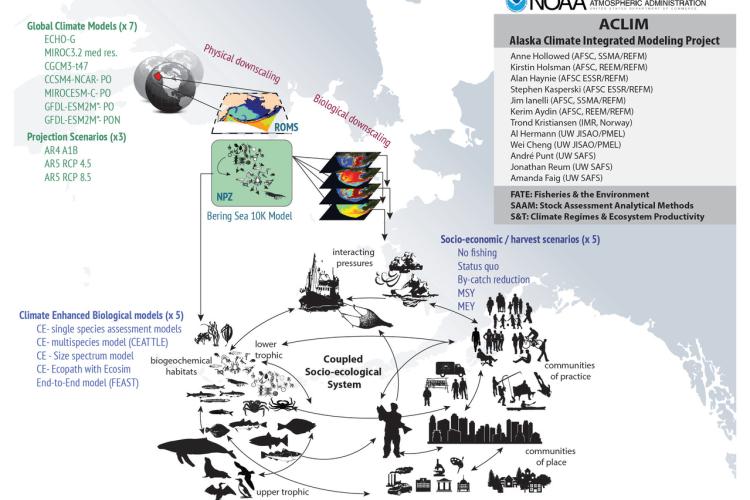The Alaska Climate Integrated Modeling Project (ACLIM) is made up of an interdisciplinary team of 50+ professionals. The team has various backgrounds ranging from biology to social sciences. Scientists are actively researching the impacts of climate change in Alaska’s Bering Sea.
The main goals of ACLIM include researching localized impacts of climate change, evaluating the response of the ecosystem, fisheries, and fishing communities to climate impacts, and evaluating the performance of management tools to support sustainable fisheries. The project is notable for using an iterative and integrative approach that combines disciplines, computer models, and stakeholder workshops to evaluate climate change impacts and solutions for Bering Sea fisheries and communities.
Climate change is rapidly altering the Bering Sea with cascading impacts on the marine ecosystem and people that depend on it for livelihoods and wellbeing. Between 2015 and 2018, ocean temperatures were above average, and in 2021, warmer temperatures were identified as likely contributors to declines in snow crab and red king crab populations. In 2018, sea ice in the Bering Sea was at its lowest point in more than 5,000 years – conditions scientists didn’t expect to witness for another 30 years or more. Climate change is at the doorstep of Bering Sea fisheries and is a challenge that needs to be addressed immediately.
ACLIM scientists want to help resource managers, fishermen, subsistence and coastal communities anticipate how climate change may affect them and know what responses may reduce impacts and promote resilience. They are doing this by taking information from Global Climate models to produce regional models that can be used to help predict future impacts at finer scales. This can then help fisheries and communities make decisions that will decrease their impact while increasing their resilience to changes like sea level rise and fluctuating marine populations. In the long run, the hope is that practices for environmental decision-making will evolve and partnerships between local communities and scientists will grow.
ACLIM and Alaska may seem distant to those in the lower 48, but the state is home to ecosystems and people that expand beyond its borders. With an abundance of wildlife, Indigenous cultures, and some of the world’s most prominent commercial and recreational fisheries, climate impacts in the Bering Sea stand to surface in communities and ecosystems in and out of the region. ACLIM hopes to inspire approaches to address climate change through a collaborative lens.
Over the next few months, I will be working with the ACLIM team to assess the challenges and opportunities of the project’s current communication methods. I aim to find the obstacles of relaying research to stakeholders and assess how to improve approaches of communicating complex climate issues to management and decision-makers. Through my research, I hope to assist ACLIM in bridging the gap between scientists and stakeholders by evaluating the needs of the team, community, and environment.
About The Author
I am an Environmental Studies major at the University of Washington and an environmental communication intern with the ACLIM team. During my internship I aim to learn how to further connect climate science with decision-making. Through this blog, I hope to provide a platform and resource to audiences who want to better understand the research, people, and significance of ACLIM.
My passion for the wildlife in the Pacific Northwest inspired me to learn how climate change is impacting our environment and communities and how we can implement effective changes. When I’m not studying or working, I’m usually found reading science fiction, kayaking, hiking, or cooking.





